23 Best Things to Do in Rome, Italy (+Map of Top Sights)

This site contains affiliate links, which means that we may earn a small commission, at no cost to you, for qualifying purchases. It supports the work that goes into keeping this content free. Thanks for reading! More info: Privacy Policy.
Looking for the best things to do in Rome, Italy, and wondering what’s truly worth your time? Of course, iconic sights like the Colosseum, Trevi Fountain, Vatican, and Pantheon are a must – but there’s so much more to explore!
To help you plan your trip, this guide covers the top sights, must-see attractions, and unique experiences you shouldn’t miss in the Eternal City. We’ve also included insider tips, practical info, and a detailed map of the top places to visit in Rome.
Rome is like an open-air museum, packed with history at every turn. While no list can cover it all, we’ve handpicked the most famous landmarks, unforgettable experiences, and personal favorites to make your visit even more special.
Ready to discover the best of Rome? See our detailed guide below!
PRO TIP: For the best experience and easy access to Rome’s top sights, stay in the historic city center – ideally between the Trevi Fountain and Piazza Navona. 9Hotel Cesari is one of our favorites, but this area is full of fantastic options.
READ ALSO: Where to Stay in Rome
How to use this guide: We begin our list of the best things to do in Rome with the must-sees. The first 16 attractions are the ones you really shouldn’t miss.
However, it’s those additional experiences from #17 onward that will make your trip even more special. We highly recommend including a few of these in your itinerary for a more unforgettable visit!
To help you plan, you’ll find a map of all the top places at the end of this guide, along with sample itineraries for different trip durations.

Here are some of the VERY BEST places to see and things to do in Rome:
1. Colosseum
MUST DO: Visit the Colosseum Underground & Arena Floor.
The Colosseum is one of the most iconic landmarks in Rome, and an absolute must-see. No matter how much time you have in the city, it should be on every Rome itinerary!
Built as an entertainment arena at around 70 AD, this impressive stone amphitheater still stands today, giving you a unique opportunity to get a glimpse into its 2000-year-old past.
There are several things that you can do at the Colosseum and various levels that you can visit. I recommend going for the full experience – from discovering the secrets of the Colosseum Underground to taking the unique opportunity to stand on the partially restored Arena Floor, to soaking in the most impressive views from the upper levels.
Good to know: The Colosseum is one of Rome’s top attractions, so booking tickets in advance is a must! To avoid the crowds and make the most of your visit, we recommend a guided tour. A local guide will help you navigate the site, explain its history, and bring the Roman Empire to life. There are countless guided tour options, but make sure to check what’s included!
TIP: We took a tour that includes the Colosseum Underground. Some tours also include the Arena Floor and/or a guided visit to the Roman Forum and Palatine Hill. Either way, we are glad we took a tour. With priority entrance and a guide, we didn’t have to worry about navigating the crowds, finding the right entrances, or figuring out what to see at the vast Roman Forum and Palatine Hill. The guide truly enhanced our experience and made it stress-free.
READ ALSO: How to Visit the Colosseum (all levels, tickets, and tours explained in detail)



2. Pantheon
MUST DO: See the oculus of the Pantheon.
The Pantheon, located on the beautiful Piazza della Rotonda, is one of the top places you can’t miss in Rome. Originally built as a temple to all gods, the Pantheon dates from before Christianity. The building as we know it today was built around 125-127 AD on the site of an even older temple. The Pantheon is the world’s oldest building that is still in use today.
While most old temples and ancient Roman landmarks suffered from looters and plundering, the Pantheon was saved by the fact that it was converted into a church at the beginning of the 7th century.
Best known for its impressive dome with an oculus in the middle, the Pantheon is also one of the most fascinating buildings in Rome. The construction of this dome by an unknown ancient architect has been an inspiration to Michelangelo’s dome of St. Peter’s Basilica in the Vatican, Hagia Sophia in Istanbul, and – subsequently – all the other domes in the world.
Good to know: The Pantheon is still a working church, but it’s also one of the most popular tourist attractions in Rome. Nowadays, you need an entry ticket to visit the Pantheon. We highly recommend reserving skip-the-line tickets in advance to avoid wasting time waiting in long lines (sometimes over an hour in the heat with no shade).
TIP: With nearly 2,000 years of history, the Pantheon is a fascinating place with so much history. Most online tickets come with an audio guide, which will offer deeper insights into this incredible landmark.
READ ALSO: Ancient Roman Landmarks You Can See in Rome Today



3. Trevi Fountain
MUST DO: Throw a coin in the Trevi Fountain.
No trip to Rome is complete without visiting the iconic Trevi Fountain. According to legend, tossing a coin in the fountain ensures you’ll return to the Eternal City. Having thrown more than my fair share of coins over the years, I can confidently say it works—we always find our way back to Rome. 😉
There are also two other reasons to toss a coin: one to find love in Rome, and the other to get married here. Each requires a separate coin, so no combining them!
Before you throw your coin, you should know that there is just one right way to do it: stand with your back to the fountain and toss the coin over your left shoulder with your right hand.
TIP: To see the Trevi Fountain without the crowds, visit VERY early in the morning, preferably at sunrise. For the rest of the day and in the evening, it’s always crowded here.
Good to know: If you have extra time and are looking for something a bit more unique to do in Rome, consider exploring the Trevi Underground. It’s a fascinating opportunity to see the remains of ancient Rome, hidden just beneath your feet, and a place most tourists never even realize exists.


4. Sistine Chapel & Vatican Museums
MUST DO: Admire the ceiling of the Sistine Chapel, visit Raphael Rooms, Vatican Gardens, and see the Momo Staircase.
Seeing the Sistine Chapel at the Vatican Museums should be at the top of any Rome bucket list! The Sistine Chapel (Cappella Sistina) is the papal chapel built at the end of the 15th century. Originally called ‘Cappella Magna’, it was later renamed after the Pope who built it, Pope Sixtus IV.
It’s here that the papal conclave takes place when the new Pope has to be elected. But don’t look for the famous chimney where the black or the white smoke comes out during the conclave – it’s only installed at that time and is not something you can see when you visit.
The Sistine Chapel is famous for Michelangelo’s stunning ceiling, painted between 1508 and 1512. It’s a masterpiece of the High Renaissance, with details and perspectives that can make the frescoes seem almost three-dimensional. Take your time to appreciate it – it’s easy to see why it’s considered one of the greatest works of art in history.
But there’s more to the Vatican Museums than just this famous chapel! Some of our favorites include the four Raphael Rooms, the Gallery of Maps, and the famous Momo Staircase. You can also stroll through the gardens, but only a small part is accessible from the museum; the rest can only be seen with the gardens tour.
TIP: The Vatican Museums are always busy, and tickets usually sell out long in advance. It’s essential to book your tickets upfront! That said, if you want to be sure that you see all the musts, I highly recommend visiting here with a guide. Otherwise, just follow the signs and you’ll eventually get to the Sistine Chapel, but keep in mind that the Vatican Museums are overwhelming for a first-time visitor.
Our recommendation: Check out this amazing early-morning tour of the Vatican and see the Sistine Chapel before the biggest crowds arrive. If you are looking for a truly special experience (and don’t mind splurging big time), the Alone in the Sistine Chapel VIP Tour is one of the most unique things you can do in Rome!




5. St. Peter’s Basilica
MUST DO: See Michelangelo’s Pietà, visit Papal Tombs & climb the Dome of St. Peter’s Basilica. Don’t miss the famous Swiss Guard!
St. Peter’s Basilica is the world’s largest and most important Catholic church. Its immense scale is hard to grasp until you see it up close, especially from the inside. Built on St. Peter’s tomb, the basilica also houses the crypts of many Popes, which are worth visiting.
One of the most unique experiences in the Vatican is climbing to the top of St. Peter’s Dome. Not only do you get stunning views of Rome and the Vatican, but you can also walk along the interior gallery, offering a true sense of the church’s size.
On your way out of the church, on your right, just before the post office, you can see the famous Swiss Guard in their colorful uniforms, guarding the official entrance gate to the Vatican.
Good to know: Entry to St. Peter’s Basilica is free, but expect long lines and security checks. To climb the Dome, you’ll need a ticket, and we recommend taking the elevator for the first part of the climb—there are still 330 steps to reach the top! We recently did this St. Peter’s tour that included a guided visit of the church itself, the underground crypts, and the Dome climb.
PRO TIP – the best Vatican tour: This highly rated tour includes early access to the Sistine Chapel and a special-access passage to skip the entrance lines at St. Peter’s Basilica, which saves you lots of time. After the tour, you can climb the dome on your own if you want to. However, this tour is very popular, so book ahead!
READ ALSO: Most Beautiful Churches to Visit in Italy





6. Roman Forum
MUST DO: Walk on Via Sacra and see the (ruins of) some of the oldest buildings in Rome.
To step back in time and experience what the city of Rome looked like 2000 years ago, there’s no better place to be than the Roman Forum (Forum Romanum).
Located next to the Colosseum, this vast archaeological site was once the heart of Roman public life. As you walk along Via Sacra, imagine the triumphal parades that took place here. The ruins of numerous Roman Empire-era buildings bring the past to life.
The Forum also offers a unique glimpse of the “dust of centuries.” The site lies much deeper than the current street level, and you can spot the famous ‘hanging’ door of the Temple of Antoninus and Faustina, showing how much the street level has changed over time.
TIP: Though the Roman Forum deserves a good chunk of your time, it’s best visited alongside the Colosseum and Palatine Hill (all included in one ticket). Many Colosseum tours also cover the Forum, and I recommend visiting with a local guide to fully appreciate the historical significance of the landmarks around you.
We took a small group tour that included a guided visit to the Colosseum (incl. the Underground and the Arena Floor), Palatine Hill, and the Roman Forum, and we were really glad we did. This was not the first time we visited these places, but we learned so much and saw so much more than on the previous unguided visits. If this is your first time in Rome, do yourself a favor and book a tour!




7. Palatine Hill
MUST DO: Admire the views from Terraza Belvedere del Palatino, see the old palaces, gardens, and fountains.
Palatine Hill is the most famous of the seven hills of Rome and one of the oldest parts of the city. In ancient times, this was the chicest and most desirable neighborhood of Rome, the place-to-be for the rich and the famous.
Nowadays, Palatine Hill is an open-air museum/ archeological site, where you can see the remains of some grand palaces of the Roman empire. It also offers some of the best views in the city, with the Roman Forum and Colosseum on one side and Circus Maximus on the other side.
There are several viewpoints on Palatine Hill. By far the best view is from the terrace overlooking the Roman Forum and the city center, Terrazza Belvedere del Palatino.
Good to know: An entrance ticket to the Palatine Hill is included with your Colosseum/ Forum Romanum ticket, and a visit here is not to be missed. You could spend hours exploring all the ruins, but in all honesty, going without a tour guide, it will be difficult to understand what you are seeing.
TIP: Just as with the Colosseum and Forum Romanum, we highly recommend that you visit the Palatine on a guided tour. There are so many great tours that cover all these sights in just a few hours, so you can easily find one that will suit your interests. No matter which tour you choose, it will be a hundred times better than trying to make sense of all the ruins on your own. Just be sure to read the tour description so that you know what is included (and which parts are guided or not).



8. St. Angel’s Bridge
MUST DO: Admire the angels of St. Angel’s Bridge.
Probably the best-known and definitely the most photographed bridge in the Eternal City, St. Angel’s Bridge (Ponte Sant’ Angelo) is another landmark not to be missed in Rome.
The bridge was built in 134 AD by Emperor Hadrianus in order to connect his mausoleum (that is now known as Castelo Sant’ Angelo) to the city. This beautiful bridge and its surroundings have a long history and it’s been improved a lot over the centuries.
If you walk to the Vatican from the historic center of Rome, be sure to walk over St. Angel’s Bridge. It’s so impressive! This pedestrian bridge is lined with the statues of 10 angels (5 on each side) and right in front of you, stands Castello Sant’Angelo. The angels were commissioned by Pope Clement IX and made by the pupils of Bernini (17th century).
Interesting fact: Bernini himself made two angels for this bridge as well, but the Pope found them too beautiful and too valuable to be placed on the bridge. So the originals were replaced by the copies. If you want to see the two original angels, you can admire them at the Sant’ Andrea delle Fratte church in Rome.
This bridge serves as a gateway to the Vatican and is often extremely busy, especially during the opening hours of the Vatican Museums and St. Peter’s Basilica. But if you can come here early in the morning before the crowds arrive, it’s absolutely magical!
TIP: If you want to see some nice views of Rome’s cityscapes, visit the rooftop of Castel Sant’Angelo. If you are short on time, this museum is not an absolute must in Rome, but those views are amazing! If you decide to visit, be sure to get the fast-track tickets in advance!
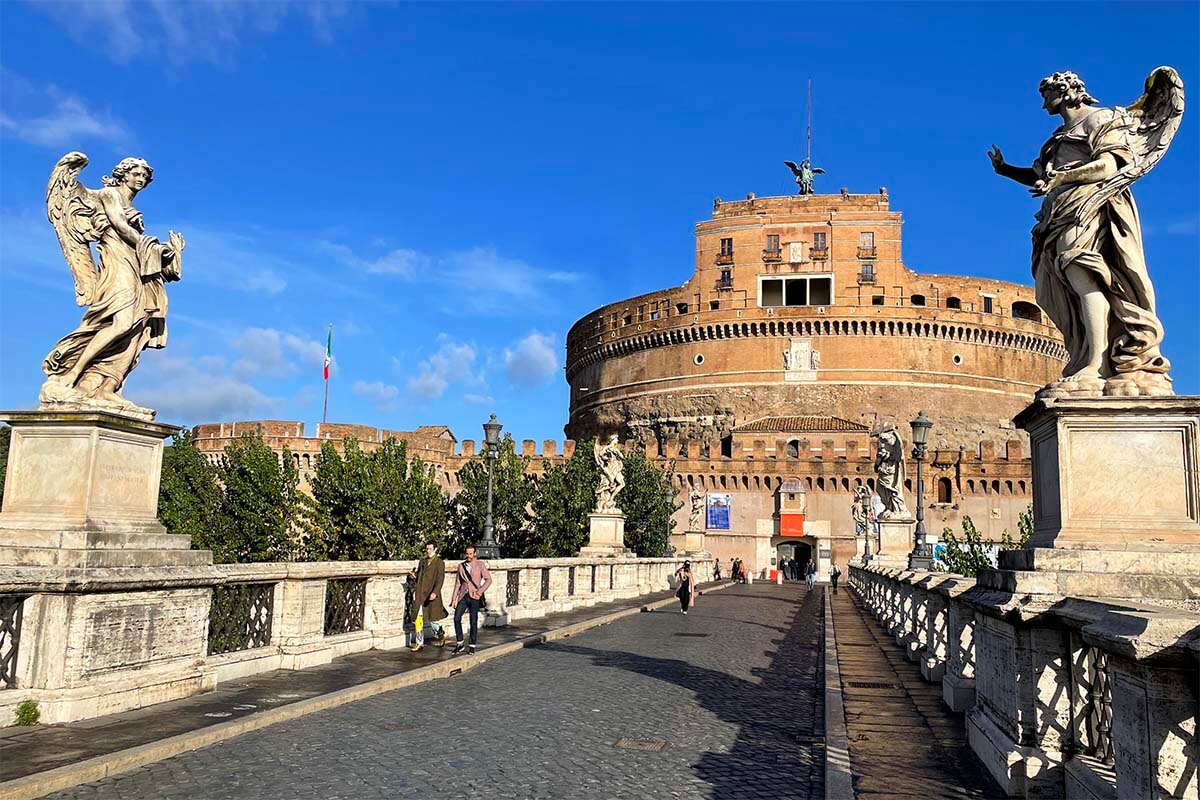

9. Piazza Navona
MUST DO: See the fountains.
Probably the best-known of all the town squares in Rome, Piazza Navona is the biggest and also the most beautiful one. And no trip to Rome would be complete without at least a quick visit here.
Piazza Navona has a rather unique – very long – shape. This is because it was built on the site of the ancient Roman Stadium of Domitian and follows its form.
In the center of Piazza Navona, stands a big obelisk and the 17th-century Fountain of the Four Rivers (Fontana dei Quattro Fiumi). It was designed by Bernini and is one of the most beautiful fountains in Rome. In addition, don’t miss two other impressive fountains – the Fountain of Neptune (Fontana del Nettuno) on the northern side of the square and the Moor Fountain (Fontana del Moro) on the southern end.
In addition, check out the impressive 17th-century Baroque church of Sant’Agnese in Agone. The church is dedicated to St Agnes, an early Christian martyr, who was executed at the Stadium of Domitian at this location.
Nowadays, Piazza Navona is a bustling meeting place, with lots of cafes and restaurants lining its sides. Just beware that a cup of coffee here costs 2-3 times the price of other cafés nearby, and the quality of the food isn’t amazing. But if you want to sit down and do some people-watching, it’s a beautiful place for that!
TIP: While the early morning is the best time to take pictures of Piazza Navona without the crowds, be sure to come here in the evening as well. It’s such a lively and bustling place and it feels totally different than during the day.
Interesting to know: Piazza Navona was built over the ancient Roman site of the Stadium of Domitian. It is now possible to visit this fascinating archeological site underneath the square. You can find more info and get tickets here.

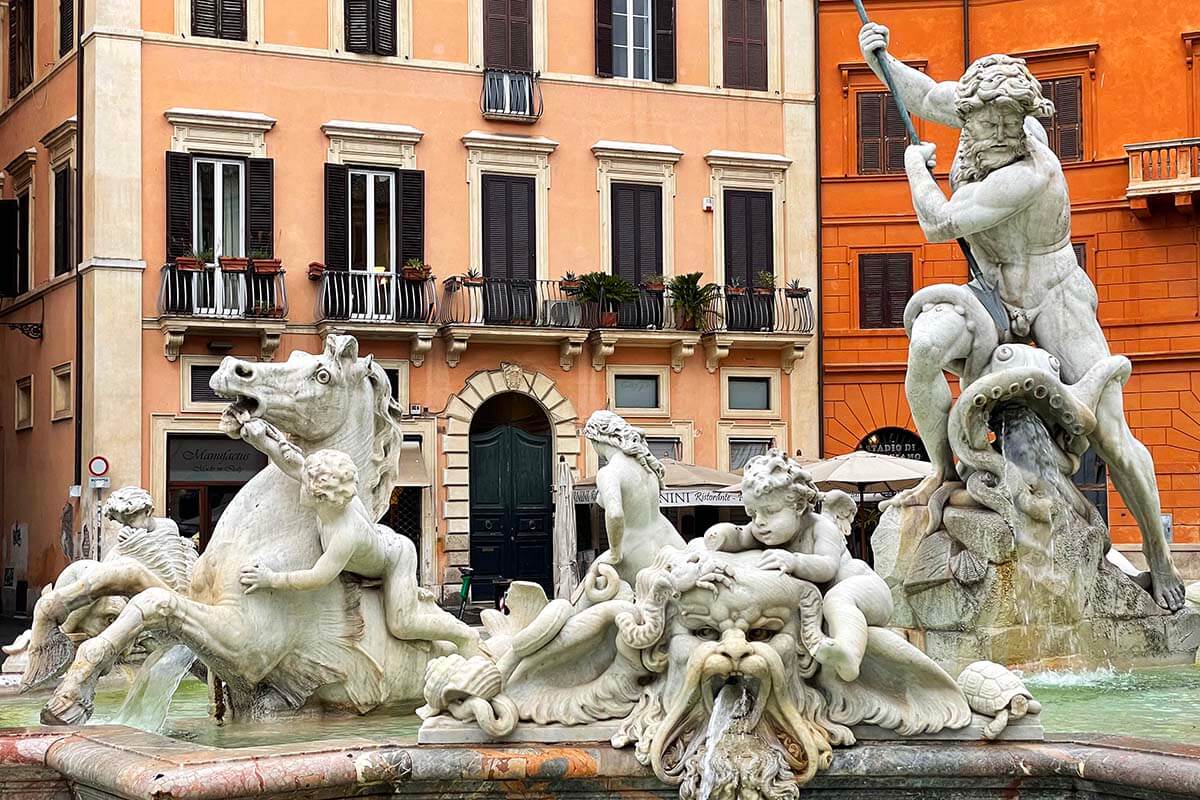

10. Campo de’Fiori Market
MUST DO: See the statue of Giordano Bruno and buy some local delicacies at the market.
Campo de’ Fiori is one of the nicest town squares in Rome. As its name suggests, in the past, it was a field of flowers and was only developed in the 15th century. It quickly became a popular gathering and trading place, but also a site for many religiously-tinted executions.
In the center of the square, stands the statue of martyr Giordano Bruno. He was a 16th-century philosopher who was burned alive for his progressive thinking (supporting Copernic’s idea that the Earth is rotating around the sun and not the other way around).
Nowadays, Campo de’ Fiori is the site of a bustling market where you can buy all kinds of local produce, exotic fruit, flowers, etc. While some market stalls are catering mainly to tourists with all kinds of Italian pasta, colorful liquors, etc., the market is also popular with the locals who come here for fresh fruit, vegetables, cheeses, and meat.
Good to know: The market is open daily except on Sundays, between 7 AM and 2 PM. In the evening, Campo de Fiori is a popular gathering place, and there are lots of nice restaurants and cafes in this area. But – as it usually is with places to eat in Rome – the restaurants on the square itself are quite expensive and don’t always have the best reputation. So check out the ones a bit further away.
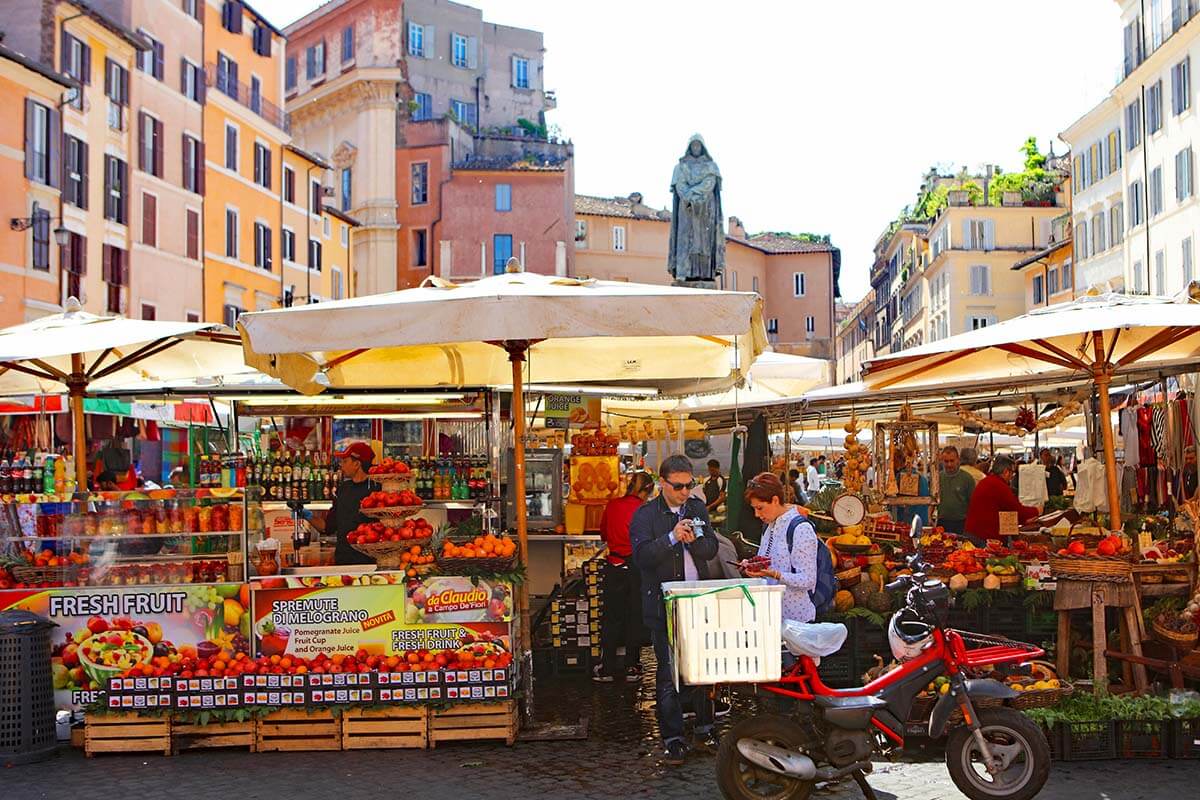



11. Piazza Venezia
MUST DO: See the huge, temple-like Altar of the Fatherland monument.
Piazza Venezia is a big and very busy square squeezed in between the city center on one side and the Roman Forum on the other. It’s one of the must-see places in Rome that you’ll inevitably pass on your way to/from the Colosseum.
Piazza Venezia is best known for the colossal monument – Altar of the Fatherland (Altare della Patria) – and the equestrian statue of Vittorio Emanuele II. But – just as everywhere in Rome – there’s so much more to see and do here, including ancient ruins, several churches, the nearby Capitoline Hill and Museums, etc.
TIP: If you have some time to spare, you can also take an elevator to the top of the monument for panoramic views of Rome. It’s well worth it. You can find more info and get tickets here.



12. Trajan Forum & Via dei Fori Imperiali
MUST DO: Walk Via dei Fori Imperiali.
One of the must-see streets of Rome – Via dei Fori Imperiali – links Piazza Venezia to the Colosseum. This wide avenue lined with statues of the Roman emperors is like a museum in itself.
On one side, you have the earlier-mentioned Roman Forum, and on the other – the archeological sites of the Forum of Augustus, Trajan Forum, and many other historic places.
You can see a lot from the street and there are some information panels here and there. So you can just walk around a bit and try to imagine what Rome must have looked like more than 2000 years ago. If you have some extra time, you can also visit several museums here. Trajan’s Market, a 2nd-century Roman market, is quite interesting to see. For more info and tickets, see here.




13. Capitoline Hill
MUST DO: See the Capitoline She-wolf, the symbol of Rome.
Capitoline Hill (Campidoglio) sits right next to Piazza Venezia. This beautiful square and the impressive staircase leading to it were designed by Michelangelo. Here, you’ll also find the City Hall of Rome and Capitoline Museums, which house a big collection of Roman, Greek, and Egyptian antiques.
This is also where you can see the statue of the Capitoline Wolf (Lupa Capitolina), the symbol of Rome.
This statue depicts an old legend, according to which a she-wolf saved and cared for Romulus and Remus, the twin brothers who later founded the city of Rome. The original statue can be found inside the museum, but you can also see its replica outside.
TIP: Behind the city hall, you can also find a panoramic terrace with nice views of the Roman Forum. This is one of the best viewpoints of Rome that is super easy to visit.



14. Spanish Steps & Piazza di Spagna
MUST DO: Explore Piazza di Spagna and walk to the top of the stairs.
Piazza di Spagna and the Spanish Steps is another of the must-see places in Rome.
Built in the early 18th century, these stairs connect Piazza di Spagna in the historic city center to Piazza Trinità dei Monti on top of the hill. It’s an impressive staircase that has been featured in various movies and is also often depicted on many postcards and travel guides. Every spring, the staircase is decorated with beautiful flowers, and it looks even more beautiful!
At the bottom of the stairs, you’ll see the Fountain of the Boat (Fontana della Barcaccia), just one of the many of Bernini’s masterpieces in Rome. Piazza di Spagna is also lined with colorful buildings and surrounded by the most luxury boutique shopping area in Rome. Here, you’ll also find some nice cafes and restaurants. If you like cakes or the English tea experience (and don’t mind the high price tag), check out the famous Babington’s tea room at the bottom left of the stairs.
At the top of Spanish Steps stands Trinità dei Monti Church. The church is nice, but not an absolute must, but it’s worth going up the stairs just to say that you’ve done it and also for the nice views of the city. For even better views, don’t go back the same way you came, but continue to the left in the direction of Pincio Terrace and Piazza del Popolo (more info below).
Good to know: It is forbidden to sit or eat on the Spanish Steps. It’s a beautiful monument and the city tries to preserve it that way.
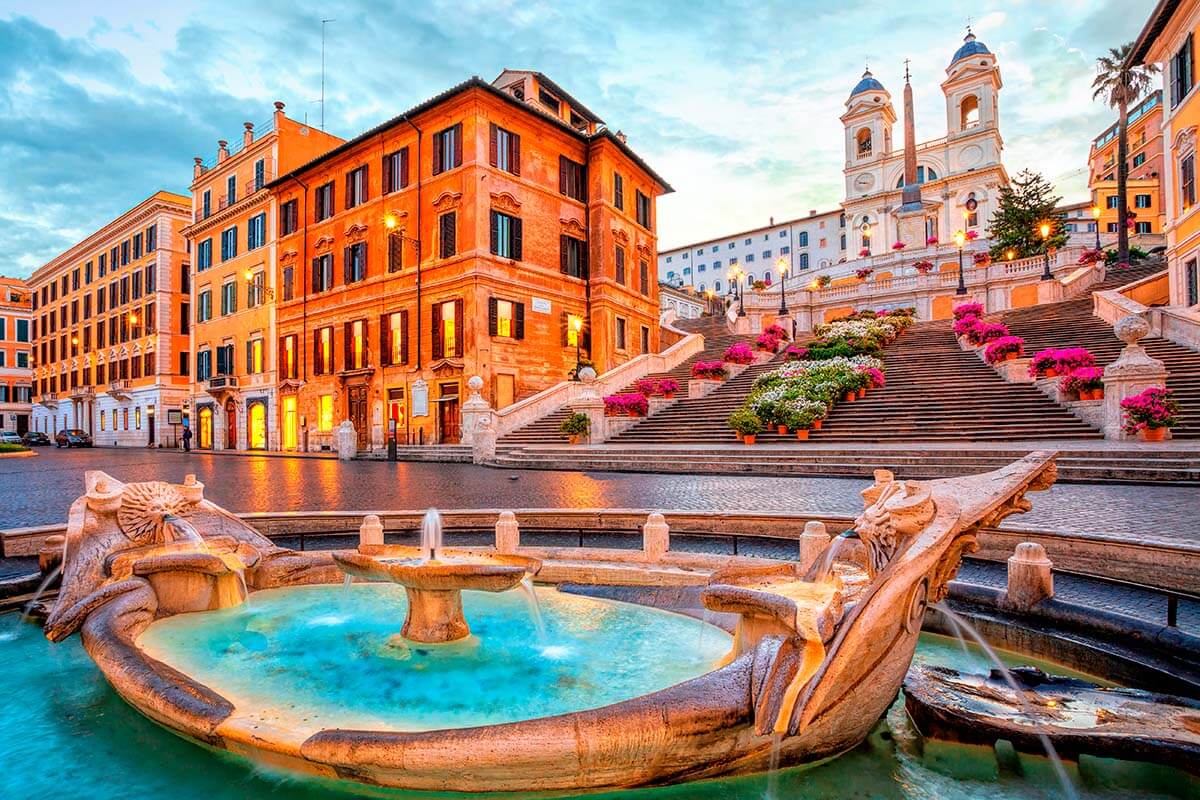
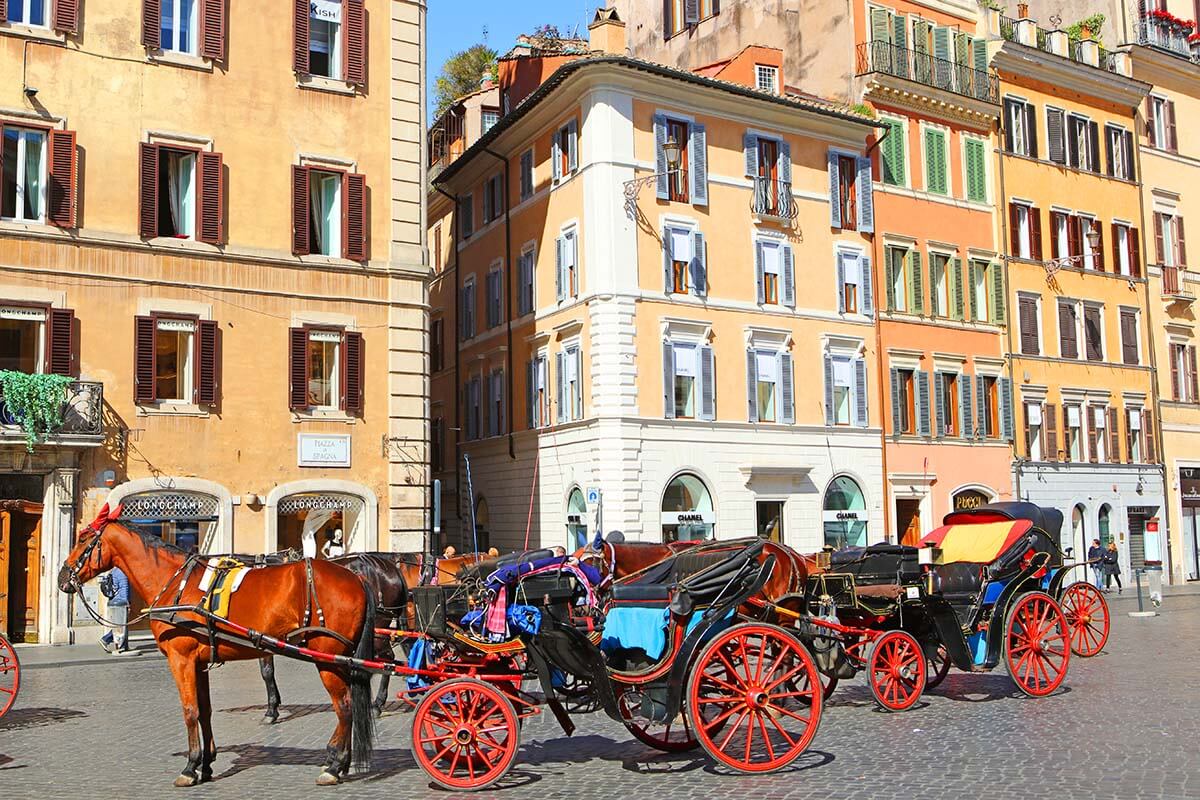

15. Villa Borghese Gardens & Gallery
MUST DO: See the art masterpieces at Villa Borghese Gallery and also be sure to explore the park.
Villa Borghese is one of the biggest and most beautiful parks in Rome. It’s best known for the Borghese Gallery, a beautiful villa-museum that houses some of the most beautiful artworks by Bernini, Caravaggio, Raphael, Canova, and others. Art lovers consider this as one of the best museums to visit in Rome!
While the Gallery only requires an hour or two, the park itself is huge and you could spend an entire day walking around. There are several other museums here, fountains, walkways lined with sculptures and art, flower gardens, playgrounds for kids, and even a zoo. In summer, you can also rent a boat on the small lake, rent bikes, etc.
Good to know: If you want to visit the Borghese Gallery, you have to book in advance! Also, the tickets are timed, so be sure to arrive on time. You can opt for a regular entrance ticket or join a tour. If you want to see the best of the museum and the gardens in just a few hours, we recommend going on a tour. If you are short on time, just get a ticket and walk through the museum on your own.



16. Piazza del Popolo
MUST DO: See the obelisk and the fountains.
Piazza del Popolo (literally ‘the People’s Square’) is another large and impressive town square that deserves a quick visit. It’s located at the Aurelian city walls, right at one of the old city gates of Rome, Porta Flaminia.
Piazza del Popolo is a huge square, a place where several big streets meet. One of the streets leads in the direction of the Vatican, the other – towards the Pantheon and Piazza Navona. The famous Via del Corso leads towards Piazza Venezia and the Colosseum, and Via del Babuino – towards Piazza di Spagna and the Spanish Steps.
In the center of Piazza del Popolo, stands an Egyptian Obelisk and the Fountain of the Lions. There are two other fountains – Fontana del Nettuno and Fontana della Dea di Roma – at the western and eastern sides of the square. And it’s also flanked by two impressive churches Santa Maria dei Miracoli and Santa Maria di Montesanto.
TIP: If you want to experience the ‘wow’ effect that Rome’s first-time visitors must have had upon arrival, be sure to enter the square via the city gate.


Now that we covered the absolute must-see places in Rome, I really want to add a few more places and experiences to this list. It’s these additional sights and activities that will make your trip to the Eternal City so much more special!
These are worth it just as much as the musts listed above!
Here are some more amazing things to do in Rome that we highly recommend for a more unforgettable experience:
17. Check out some of Rome’s best viewpoints
The city of seven hills, Rome has quite a few places from where you can admire some panoramic views of the city and its surroundings.
We already mentioned the views from St. Peter’s Dome, Palatine Hill, or from the top of the monument at Piazza Venezia. In addition, don’t miss the views from Pincian Hill, Gianicollo Hill, and potentially also from Aventine Hill. We indicated all of these on our map of Rome attractions at the bottom of this post.
Pincian Hill is located between Piazza del Popolo and Villa Borghese gardens. Some of the best views can be found at Terrazza del Pincio and a smaller terrace to the east of it. These are very popular sunset viewpoints in Rome offering stunning views of the city center with St. Peter’s Basilica in the distance.
Belvedere del Gianicolo viewpoint on Gianicollo Hill is located on the other side of the river, and almost on the opposite side from Pinician Hill. It gives a great view of the city center as well.
Orange Garden (Giardino degli Aranci) on Aventine Hill is another beautiful place for stunning cityscapes and panoramas.
LEARN MORE: Best Views in Rome (+ photos & a map with exact locations)


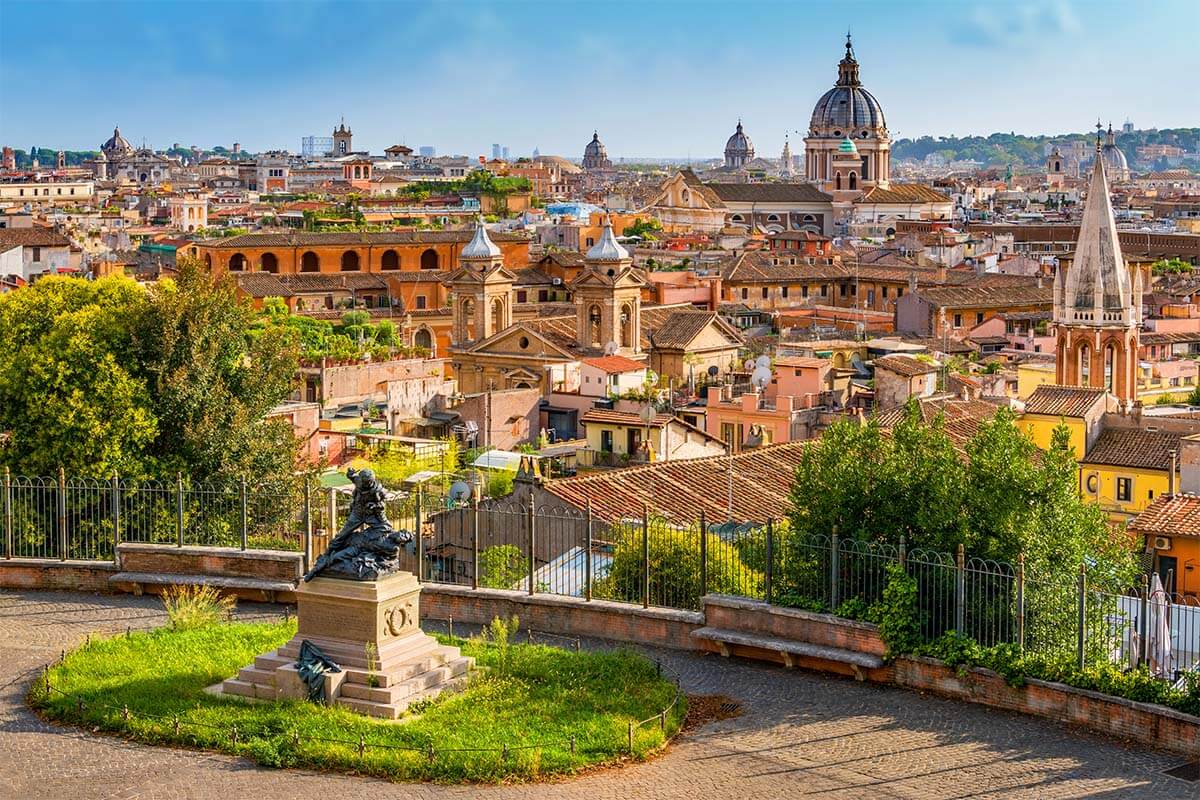
18. Bike the Ancient Appian Way
For a truly unique experience in Rome, I highly recommend biking along the ancient Appian Way. Walking or driving on a road that’s over 2300 years old is a feeling you have to experience to fully appreciate.
Built between 312-264 BC, the Appian Way connected Rome to Brindisi in Southern Italy, serving mainly military purposes to expand the Roman Empire. Spanning over 563 km (350 miles), it’s rich in history. The road is also lined with mausoleums and family graves, as it was once forbidden to bury people inside the city.
While you can walk the Appian Way, biking offers a far better experience. The most scenic sections are quite a distance from the city center (or the bus stop), and walking that far can be tough. A bike lets you cover more ground and get a better feel for this historic route.
TIP: The Appian Way is very bumpy, so it’s best to use a sturdy electric mountain bike. We did an e-bike tour that covered not only the Appian Way but also the Catacombs of St. Calixtus, ancient aqueducts, city walls, and more. To me and my teenage son, this tour was one of the absolute favorites of our recent 4-day trip to Rome. Hands-down, one of the most special things you can do in Rome!
Good to know: Various tours include a visit to the Appian Way in their itinerary (by bus, bike, golf cart, etc.). No matter which tour you choose, it’s well worth it. Going with a guide means you won’t have to worry about logistics while visiting the most impressive sections of this ancient road.
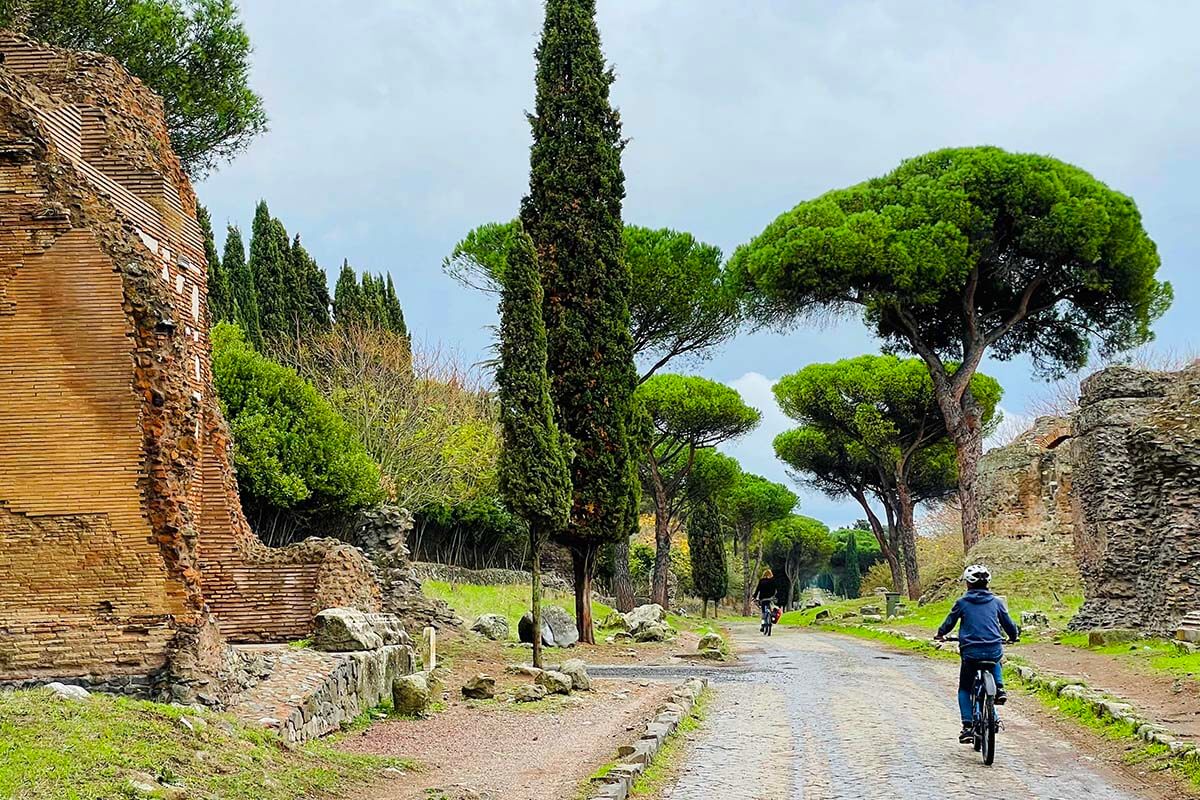


19. Take a food tour
Another personal favorite – taking a food tour – is one of the VERY BEST things to do in Rome!
There is no better way to experience the real Rome than by taking a food tour with a local guide! In the past, I always thought that you can just ‘organize’ your own food tasting by checking out some local shops, markets, or researching the better restaurants, and that food tours weren’t really worth it… But it’s really not even comparable…
Taking food tours has become our family’s favorite way to explore a new city. It’s such a great way to get to know the place, hear some local anecdotes, taste traditional dishes, and visit some cool places that most tourists don’t know about.
Anyway, back to food tours in Rome. There is such a wide variety of food tours that it might be difficult to choose. I would simply pick one that suits your itinerary the best (based on their starting times and the area they visit).
Here are some of our hand-picked recommendations:
- Street food tour. This is the tour that we did on our recent visit to Rome, and it was excellent. You can choose between the Trastevere or Jewish Quarter tour and several starting times every day, making it easy to include in any itinerary.
- Food tour in the city center + Trastevere. This is a nice food tour for those who are looking to try a wider variety of local dishes and wines. It’s more expensive because it also includes a full dinner with several wine tastings.
- Food tour near the Vatican. This is an excellent dinner tour that takes you to some very local places, far from the areas frequented by tourists. If you’re looking for a more authentic experience, you can’t go wrong with this highly-rated tour.
- For a more hands-on experience, you can also opt for various cooking classes.
No matter which tour you choose, I’m sure it will make your visit to the Eternal City so much more special. For us, it was one of the best experiences in Rome, and the only regret we had was that we didn’t think to foresee more time and do several food tours instead of just dining at restaurants. Next time we’re in Rome, we’re going for a different food tour every day!
READ ALSO: Rome Street Food Tour: Review & Tips



20. Explore the fascinating underground sites
With a rich, centuries-long history, Rome is full of unique underground sites where you can literally take a trip back in time. So no list of the best things to do in Rome would be complete without mentioning some of the best underground experiences in the city.
There are so many interesting underground sites to see in Rome and quite a few of them are open to the public and can be easily visited (albeit, often only with a guide). It can be overwhelming to even know where to start or which ones are worth it the most. So to help you out, we made a small selection of some of the best ones.
Here are a few of our favorite underground places to visit in Rome and how to see them:
- Colosseum Underground. Easy to visit with a guided tour of the Colosseum. Just be sure that the tour you book actually includes the underground level (standard tickets don’t). Here you can find a selection of tours that visit the Underground.
- Papal Tombs. Right under St. Peter’s Basilica and can be visited free of charge, but do expect a queue. We went with this guided tour of the Basilica that also included the dome climb, and somehow just entered the crypts without having to wait. So I’m not exactly sure if they have some kind of priority. But you can also visit this level and see where many Popes are buried on your own. The actual St. Peter’s tomb is located even deeper and that level is not easy to visit (requires a special Vatican tour).
- Capuchin Crypts. Located close to Piazza Barberini and quite easy to visit on your own. Many underground tours include a visit here, some in addition to some interesting places that are located much further away from the city center.
- Domus Aurea – the ‘Golden House’ of Emperor Nero. It’s located close to the Colosseum, and you can join one of the guided tours if you want to visit inside.
- St. Clement Basilica. Located just a few minutes walk from the Colosseum, this is a truly unique place. Under the 12th-century church, there’s a 4th-century basilica, and yet another level deeper, a 1st-century pagan temple. You can easily visit on your own. Tickets are available online, but you can also just get a ticket on the spot.
- Catacombs. There are many ancient catacombs in Rome, and they’re all located outside the historic city walls. So you’ll need some kind of transportation for them. The most famous are the Catacombs of St. Callixtus, and entrance tickets include a guided tour (you can only visit with one of their guides). We recommend visiting the catacombs with organized tours – that way, your transport is taken care of, and these tours usually include a few other sites. We visited the catacombs with this wonderful e-bike tour that included the Appian Way, ancient aqueducts, and more.
These are just a few examples of the best underground sites that you can easily see in Rome. Even if you just visit a few of these places, it will make your trip to the Eternal City so much more memorable. Well worth it!
LEARN MORE: Rome Underground (Best Sites + Map & Info)




21. Get off the beaten path
In addition to all the famous landmarks and popular tourist attractions in Rome, one of the best ways to get to know the real Rome is to get a bit off the beaten path.
We already mentioned the underground sites that are totally worth your time. But there’s more, so much more to see in Rome! So if you have some time to spare, check out some local neighborhoods and lesser-known sights as well!
Discover the colorful streets of Trastevere, try some local restaurants in the Jewish Ghetto, or check out the quirky architecture of Quartiere Coppede. Visit some lesser-known archeological sites, admire the stunning art at one of the many museums, or spend some time at a local market… There’s so much more to see and do in Rome than just visiting its main sights!
This is not only a great way to escape the crowds, but you also get to know the city a bit better and get a better idea of what Rome is truly like. If you are not sure where to start, through the link below, you can check out our guide to some of the nicest lesser-known places that we recommend to see in Rome.
LEARN MORE: Rome’s Hidden Gems


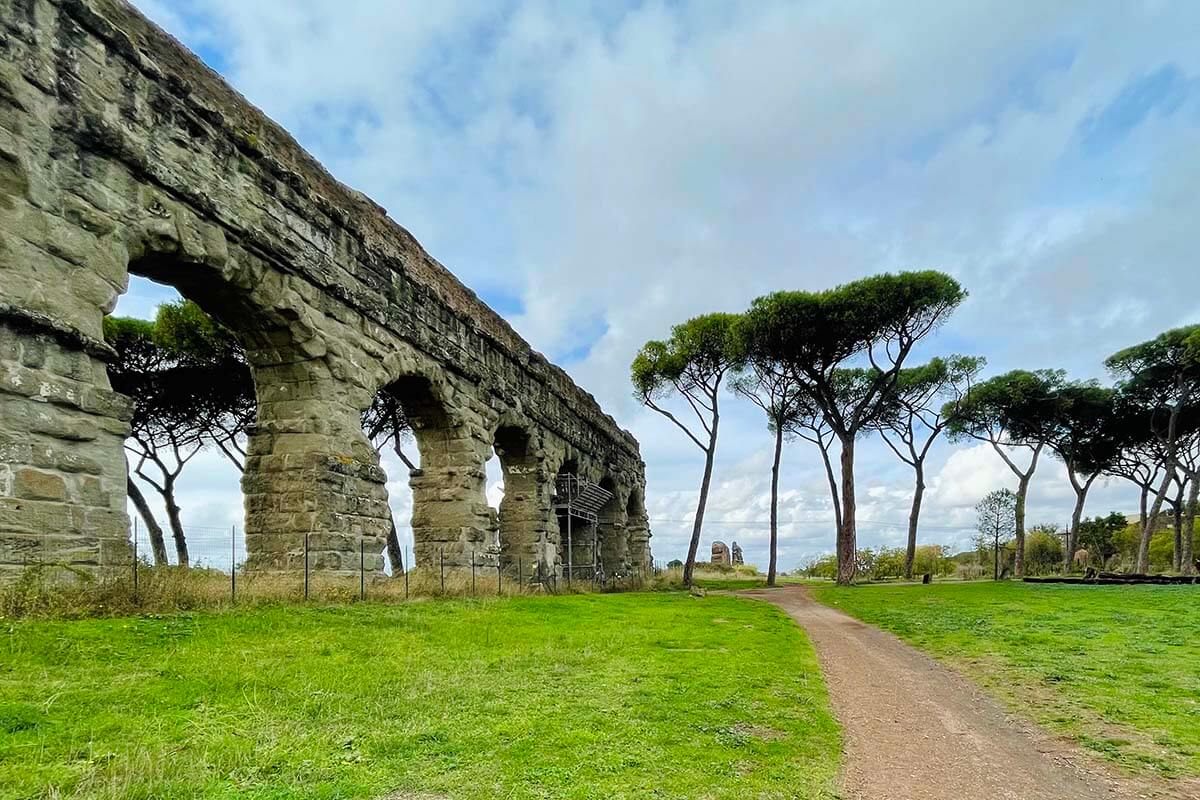
22. Go (window) shopping at luxury boutiques
Among many other things, Italy is also famous for its fashion. And while Rome isn’t as famous for fashion as Milan, you’ll find all the big names in the fashion industry represented here. No trip to Rome would be complete without doing some (window) shopping at some of the most famous luxury boutiques!
One of the best areas to go shopping in Rome is the neighborhood around the Spanish Steps – Piazza del Popolo. Here, you’ll find some of the most expensive fashion retailers in the world. In addition, there are also lots of main-street brands too.
One of the best-known luxury shopping streets is Via dei Condotti. Here, you’ll find brands like Gucci, Prada, BVLGARI, Louis Vuitton, Saint Laurent, Dolce & Gabbana, and many others. For (much) more affordable fashion, head to Via del Corso. Here you’ll find stores like GAP, Levi’s, Nike, and similar.
And even if you aren’t planning to buy anything, you really can’t say you’ve been to Rome without having walked on Via dei Condotti…
Good to know: Most stores are open daily from 10-11 AM to 7.30-8 PM.

23. Enjoy some of the best gelatos in the world
No list of the best things to do in Rome would be complete without mentioning its gelatos. Rome has some of the best ice cream in the world! You should make some time for at least one or two gelatos each day ;).
There are so many really good gelaterias in Rome that it would be difficult to mention even a small part of them. Here are some of the most famous: Giolitti and Della Palma (both very centrally located), and also Venchi (with multiple stores in the city).
TIP: Don’t just assume that every gelateria you come across is just as good, however. There are quite some places (especially close to the main tourist attractions) that sell mediocre ice cream. It’s usually still quite ok, but can’t even compare to the best artisanal ice cream, so make a bit of effort and locate a really good one!
We also indicated these and some other really good gelaterias in Rome on our map of Rome attractions below.
READ ALSO: Where to Eat in Rome



Map of Rome Attractions & Itinerary Suggestions
To help you get a better idea of where all the main Rome attractions are located, we created a map indicating all the main points of interest and top sights mentioned in this article.
This should help you plan your time a bit better. Just please keep in mind that you can only visit a few of the main tourist attractions in a day. It’s busy everywhere, distances between some sights are quite big, and even with the skip-the-line tickets, you’ll need several hours for each place (if you visit inside). So plan your time well!
TIP: If you are not sure where to start, we have some sample sightseeing itineraries that can help you plan your time in Rome:
READ ALSO: Rome Airport Transfers (from Fiumicino or Ciampino)
How to use this map: Use your computer mouse (or fingers) to zoom in or out. Click on the icons to get more information about each place. Click the arrow on the top left corner for the index. Click the star next to the map’s title to add it to your Google Maps account. To view the saved map on your smartphone or PC, open Google Maps, click the menu and go to ‘Your Places’/’Maps’. If you want to print the map or see it in a bigger window, click on ‘View larger map’ in the top right corner.
Where to Stay for Sightseeing in Rome
To make the most of your visit to Rome, we recommend staying in the heart of the historic city center.
Our favorite area to stay for sightseeing in Rome is close to the Pantheon – Piazza Navona. It’s so conveniently located that you’ll be able to visit most of the main sights of Rome on foot. Plus, there are lots of good restaurants here too.
Here are some hotel recommendations for all budgets:
- Luxury: Eitch Borromini Palazzo Pamphilj – amazing location overlooking Piazza Navona.
- Mid-budget: 9HotelCesari – a nice hotel with the most beautiful rooftop bar/ restaurant. This is where we stayed on one of the recent trips.
- Lower budget: Navona Theatre Hotel – a 3* hotel offering a very good price/ quality/ location ratio.
For more information and hotel recommendations, please see our detailed guide via the link below!
LEARN MORE: Where to Stay in Rome: the BEST Area for Sightseeing

So, this is our guide to the best of Rome. Of course, there’s so much more to see and do in Rome than we covered here. Much more than you could ever see in one short visit… But if you want to experience the VERY BEST that Rome has to offer, this list should help you do just that.
PRO TIP: Beyond the must-see sights, add a few unique experiences to your itinerary – take a food tour, bike the Appian Way, or explore an underground crypt. These off-the-beaten-path adventures will make your trip to Rome even more memorable.
For practical information and general tips, don’t miss our guide with top travel tips for Rome. It’s an essential read when planning your first visit!
More travel inspiration for your trip to Italy:
- Top Places:
- Best Cities:
- How to plan your time:
- For many more guides, check out our Italy travel guide.
If you found this post useful, don’t forget to bookmark it and share it with your friends. Are you on Pinterest? Pin these images!



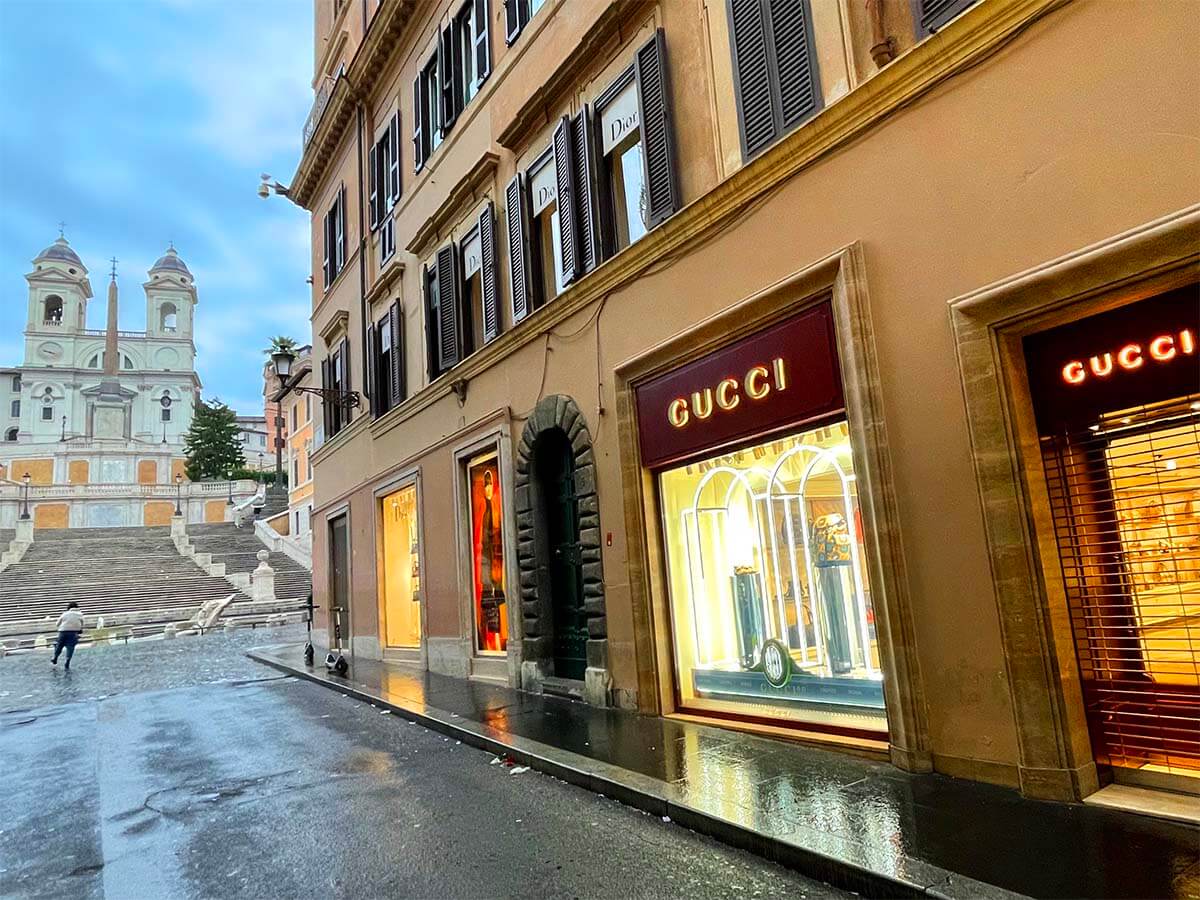

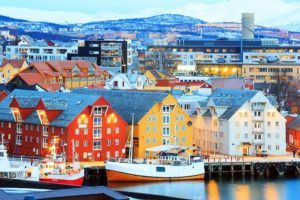





Information on Rome is excellent. No words to say thank you for interesting suggestions, valuable tips and lot more.
My salute.
Great information
KIRAN OZA
BHAVNAGAR INDIA
Thank you for the kind feedback, Kiran. Happy travels!